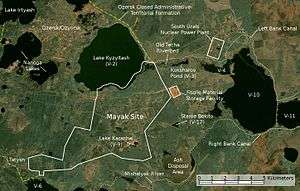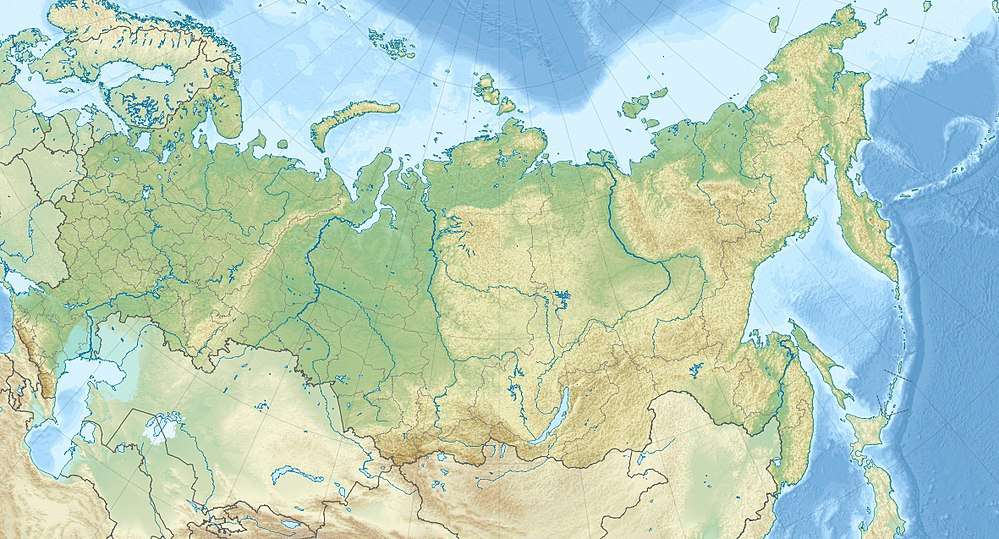Lake Karachay
Lake Karachay (Russian: Карача́й), sometimes spelled Karachai or Karachaj, was a small lake in the southern Ural mountains in central Russia. Starting in 1951, the Soviet Union used Karachay as a dumping site for radioactive waste from Mayak, the nearby nuclear waste storage and reprocessing facility, located near the town of Ozyorsk (then called Chelyabinsk-40). Today the lake is completely infilled, acting as "a near-surface permanent and dry nuclear waste storage facility."[1]

| Lake Karachay | |
|---|---|
 Lake Karachay | |
| Coordinates | 55°40′42″N 60°47′59″E |
| Type | Reservoir |
| Native name | Карача́й (Russian) |
| Basin countries | Russia |
| Settlements | Ozyorsk |
Current status
According to a report by the Washington, D.C.-based Worldwatch Institute on nuclear waste, Karachay is the most polluted (open-air) place on Earth from a radiological point of view.[2] The lake accumulated some 4.44 exabecquerels (EBq) of radioactivity over less than one square mile of water,[3] including 3.6 EBq of caesium-137 and 0.74 EBq of strontium-90.[4] For comparison, the Chernobyl disaster released 0.085 EBq of caesium-137, a much smaller amount and over thousands of square miles. (The total Chernobyl release is estimated between 5 and 12 EBq of radioactivity, however essentially only caesium-134/137 [and to a lesser extent, strontium-90] contribute to land contamination because the rest is too short-lived). The sediment of the lake bed is estimated to be composed almost entirely of high level radioactive waste deposits to a depth of roughly 3.4 metres (11 ft).
The radiation level in the region near where radioactive effluent is discharged into the lake was 600 röntgens per hour (approximately 6 Sv/h) in 1990, according to the Washington, D.C.-based Natural Resources Defense Council,[5][6] sufficient to give a lethal dose to a human within an hour. Radiation levels always decrease over time, as radioactive materials lose energy through decay. High levels of radiation are impossible to maintain, as they lose energy over time by particle emission.
As of December 2016, the lake's status is completely infilled, using special concrete blocks, rock, and dirt. It had been completely backfilled in November 2015, then monitored before placing the final layer of rock and dirt. Monitoring data showed "clear reduction of the deposition of radionuclides on the surface" after 10 months.[1] A decades-long monitoring program for underground water was expected to be implemented shortly after.[1]
Background
The name karachay means "black water" or "black sea" in several Northwestern Turkic languages, including Tatar.
Built in total secrecy between 1946 and 1948, the Mayak plant was the first reactor used to create plutonium for the Soviet atomic bomb project. In accordance with Stalinist procedure and supervised by NKVD Chief Lavrenti Beria, it was the utmost priority to produce enough weapons-grade material to match the U.S. nuclear superiority following the atomic bombings of Hiroshima and Nagasaki. Little to no consideration was paid to worker safety or responsible disposal of waste materials, and the reactors all were optimized for plutonium production, producing many tons of contaminated materials and utilizing open-cycle cooling systems which directly contaminated every liter of the thousands of liters of cooling water the reactors used every day.[7][8]
Lake Kyzyltash was the largest natural lake capable of providing cooling water to the reactors; it was rapidly contaminated because of their use of the open-cycle system. Lake Karachay was even closer; however the lake was too small to provide sufficient cooling water. Lake Karachay was then designated a close-by and convenient dumping ground for large quantities of high-level radioactive waste too "hot" to store in the facility's underground storage vats. The original plan was to use the lake to store highly radioactive material until it could be returned to the Mayak facility's underground concrete storage vats, but this proved impossible due to the lethal levels of radioactivity. The lake was used for this purpose until the Kyshtym Disaster in 1957, in which the underground vats exploded due to a faulty cooling system. This incident caused widespread contamination of the entire Mayak area (as well as a large swath of territory to the northeast). This led to greater caution among the administration, fearing international attention, and caused the dumping grounds to be spread out over a variety of areas (including several lakes and the Techa River, along which many villages lay).[8]
In the 1960s, the lake began to dry out; its area dropped from 0.5 km2 in 1951[4] to 0.15 km2 by the end of 1993.[9] In 1968, following a drought in the region, the wind carried 185 PBq (5 MCi) of radioactive dust away from the dried area of the lake, irradiating half a million people.[3]
Between 1978 and 1986, the lake was filled with almost 10,000 hollow concrete blocks to prevent sediments from shifting.[10] Conservation of the affected area continued into the 2000s via the federal target program "Nuclear and Radiation Safety in 2008 and for the period up to 2015", with the rest of the lake finally being backfilled in November 2015.[1] Conservation work was completed in December 2016 with the final layer of rock and soil being added, effectively making the former lake "a near-surface permanent and dry nuclear waste storage facility."[1]
Cultural references
- The lake and its vicinity are featured in James Rollins' Sigma Force novel The Last Oracle.
- The album "One Hour by the Concrete Lake" (1998) by Swedish progressive metal band Pain of Salvation is a concept album based on the contamination of Lake Karachay.
See also
- Hanford Site, The United States’ worst nuclear industry polluted site.
- Norilsk, The Blacksmith Institute included Norilsk in its 2007 list of the ten most polluted places on Earth.
References
- "Russia's Mayak continues clean-up of Lake Karachai". Nuclear Engineering International Magazine. Global Trade Media. 30 November 2016. Retrieved 18 August 2017.
- Lenssen, "Nuclear Waste: The Problem that Won't Go Away", Worldwatch Institute, Washington, D.C., 1991: 15.
- Pike, J. "Chelyabinsk-65 / Ozersk". WMD Information - GlobalSecurity.org. Retrieved 18 August 2017.
- "Lake Karachay". Nuclear Encyclopedia. Kose Parish, Estonia. Archived from the original on 12 March 2015. Retrieved 18 August 2017.
- Thomas B. Cochran; Robert Standish Norris; Kristen L. Sukko. "Radioactive Contamination at Chelyabinsk-65, Russia" (PDF). Natural Resources Defense Council. Archived from the original (PDF) on December 9, 2008. Retrieved 23 August 2015.
- "Soviet weapons plant pollution". WISE International. 2 November 1990. Retrieved 18 August 2017.
- "Nuclear History - The Forgotten Disasters". Nuclear-News. 2016. Retrieved 18 August 2017.
- James Martin Center for Nonproliferation Studies (6 March 2013). "Mayak Production Association". Nuclear Threat Initiative. Retrieved 18 August 2017.
- "Russia's Plutonium". Battelle Seattle Research Center. 20 May 2005. Archived from the original on 4 October 2006. Retrieved 18 August 2017.
- Clay, R. (2001). "Cold war, hot nukes: Legacy of an era". Environmental Health Perspectives. 109 (4): A162–9. doi:10.2307/3454880. PMC 1240291. PMID 11335195.
To help prevent such lethal airborne contamination, Russian engineers have been gradually covering Lake Karachay with stones and concrete blocks, a controversial remediation method.
External links
- Lake Karachay - Open-Air Depository for Radioactive Waste (in Russian)
- Karachay Lake Will Disappear in Five Years (in Russian)
- Radioactive Lake Has Been Practically Annihilated (in Russian)
- Chelyabinsk-65
- Mayak Radioactive Waste Facilities
- Google Maps Image of the lake
- Deadlier Than Chernobyl
- "Damn Interesting" article on the lake